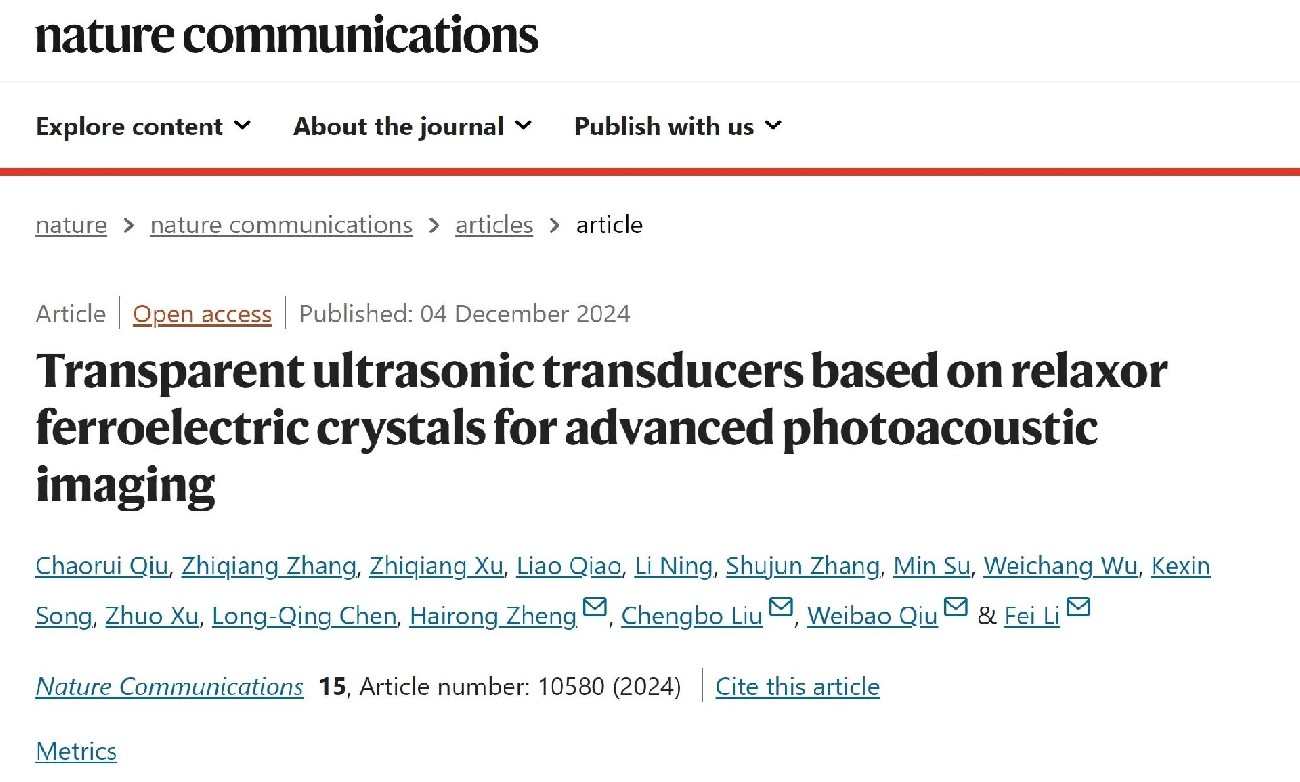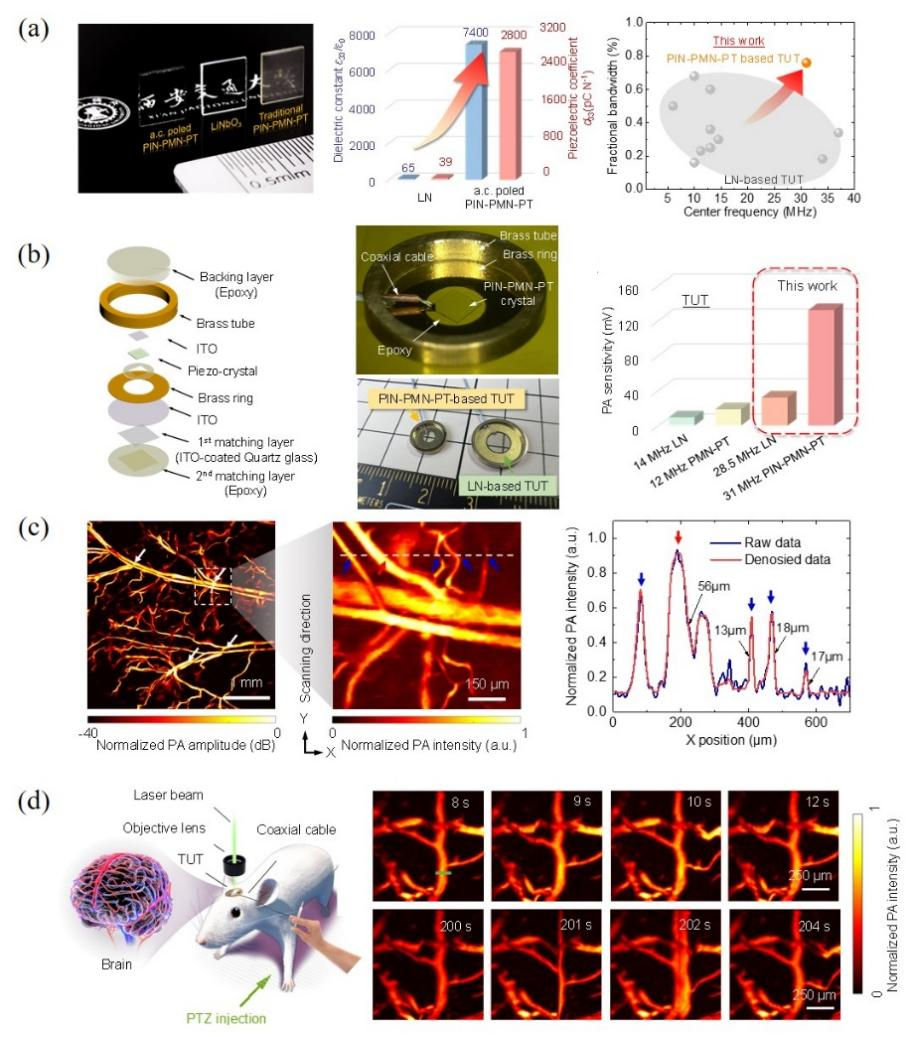Transparent ultrasound transducers, which enable high-density integration of acoustic and optical modules, are pivotal for advancing photoacoustic imaging and optoacoustic multimodal imaging toward practical applications. Conventional non-transparent ultrasound transducers face challenges in spatial coupling between optical and acoustic paths, leading to complex imaging systems and near-field blind zones. However, the performance of reported transparent ultrasound transducers still falls short of matching that of traditional ones, severely compromising imaging quality and hindering their practical applications in real-world scenarios.
On November 4th, a collaborative team led by Academician Hairong Zheng, Researcher Weibao Qiu, and Researcher Chengbo Liu from Shenzhen Institute of Advanced Technology (SIAT), Chinese Academy of Sciences, in partnership with Professor Fei Li's team from Xi'an Jiaotong University, developed a novel ultra-sensitive, broadband transparent ultrasound transducer. This breakthrough overcomes the performance limitations of existing transparent ultrasound transducers and achieves high-resolution, large-field-of-view, rapid photoacoustic microscopic imaging. The innovation paves the way for biomedical applications of transparent-transducer-based photoacoustic imaging and optoacoustic multimodal imaging. The research findings, titled "Transparent ultrasonic transducers based on relaxor ferroelectric crystals for advanced photoacoustic imaging", were published in the journal Nature Communications. The co-first authors of the paper include Chao-Rui Qiu (a jointly-trained Ph.D. candidate from Xi'an Jiaotong University and SIAT), Associate Research Fellow Zhiqiang Zhang, and Associate Research Fellow Zhiqiang Xu from SIAT.

Screenshot of the Paper’s Online Publication
The research team designed and optimized novel structures and fabrication processes for transparent transducers using a new transparent piezoelectric single crystal, overcoming performance limitations to achieve capabilities comparable with— and in some cases exceeding—those of conventional non-transparent transducers. Leveraging the developed high-sensitivity broadband transparent transducers, they successfully performed micron-resolution photoacoustic microscopy of ear microvasculature and dynamic imaging of cerebral blood flow in live mice.

Figure 1. (a) Schematic illustration of tumor-targeted imaging via bacterial delivery systems; (b) photoacoustic imaging results of mouse tumor regions under ON and OFF states of genetically encoded switchable proteins, and background noise suppression achieved by their differential signals; (c) reversible switching of photoacoustic signals from E. coli F469W carriers over multiple protein switching cycles.
1. Introduction to Transparent Piezoelectric Ultrasonic Transducers Piezoelectric ultrasonic transducers, valued for their high sensitivity, simple structure, and flexible design, are widely used in biomedical ultrasound technology. Transparent piezoelectric ultrasonic transducers, a new class developed from transparent piezoelectric materials, incorporate transparent designs for the piezoelectric layer, matching layer, backing layer, and electrodes. This allows the transducers to perform fundamental ultrasonic transmission/reception while enabling unobstructed optical paths, facilitating integration with optical systems and operations. They are ideal for photoacoustic imaging and acousto-optical multimodal imaging technologies. 2. Novel Transparent Piezoelectric Single Crystal Conventional ultrasonic transducers, typically made from lead zirconate titanate (PZT) piezoelectric ceramics or lead magnesium niobate-lead titanate (PMN-PT) single crystals, are opaque. Lithium niobate (LiNbO₃) single crystals, the common transparent piezoelectric material for transparent transducers, suffer from moderate piezoelectric performance, limiting transducer sensitivity and bandwidth. Prof. Li Fei’s team developed a PIN-PMN-PT transparent piezoelectric single crystal with high light transmittance (~70%), excellent piezoelectric properties, and temperature stability (phase transition temperature ~120°C) via a novel alternating-current polarization process. 3. High-Performance Transparent Ultrasonic Transducers Using the developed PIN-PMN-PT single crystal, the team designed a dual-layer acoustic matching structure of quartz glass and epoxy resin. Optimizing the fabrication process significantly enhanced ultrasonic transmission efficiency. By refining electrode lead structures and ITO transparent electrode performance, they achieved breakthroughs in transducer performance: ultrahigh sensitivity (two-way insertion loss -17.6 dB) and bandwidth (~80%). The transducers exhibit sensitivity and bandwidth 3.5x and 1.3x higher than the best-reported transparent transducers, respectively, matching or exceeding the performance of conventional non-transparent counterparts. 4. High-Resolution, Large Field-of-View, Fast Photoacoustic Microscopy in Live Mice Leveraging these transducers, an optical-resolution photoacoustic microscopy system (OR-PAM) was developed, enabling the first continuous dynamic imaging of brain disease models using transparent transducers. Traditional non-transparent and some reported transparent transducers require signal averaging (slowing imaging to minutes or more) or acoustic lenses (limiting field-of-view to tens of microns) due to low sensitivity. The high-performance transducers overcome these limitations, allowing the system to achieve large field-of-view (millimeter-scale), fast (0.8 Hz frame rate), and high-resolution (micron-scale, resolving single capillaries) imaging via 2D galvanometric optical scanning of live tissues. 5. Future Directions Research will advance across three fronts: transducers, imaging technology, and applications. 1) Transducer Development: The high dielectric constant of PIN-PMN-PT single crystals favors array transducer fabrication. Transparent array transducers will expand imaging fields to centimeter scales and enable multimodal fusion of ultrasound, photoacoustic, and optical imaging. 2) Imaging Technology: Integrating high-repetition-rate lasers with high-speed scanning will further boost OR-PAM imaging speed toward video-rate performance. 3) Applications: Using transducers as cranial window materials will eliminate signal attenuation from conventional materials (e.g., PDMS/PVC films), simplifying brain imaging and enabling fluorescent multimodal brain imaging. Their compact, lightweight design also supports wearable applications like head-mounted or patch-based imaging devices.